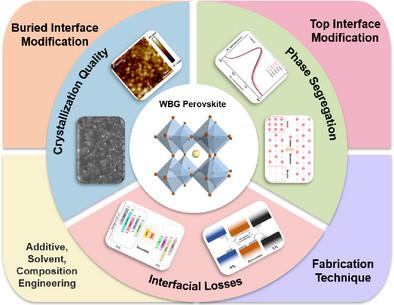Challenges and Optimization Strategies for High-Performance Wide-Bandgap Perovskite Solar Cells
IF 26
1区 材料科学
Q1 CHEMISTRY, PHYSICAL
引用次数: 0
Abstract
Tandem solar cells (TSCs) employing wide-bandgap (WBG) perovskite solar cells (PSCs) as the bottom sub-cell represent a leading research direction in photovoltaics. However, the presence of phase segregation, interfacial losses, and crystallization quality within WBG perovskite films can drive complex compositional evolution and non-radiative recombination, leading to photovoltage deficits, fill factor (FF) degradation, and impaired charge transport characteristics, which fundamentally limit the attainable high power conversion efficiency. From this perspective, this review presents a systematic optimization framework for high-performance mixed-halide WBG perovskite photovoltaics, addressing critical challenges in mixed-halide WBG PSCs through interfacial, solvent, additive, and composition engineering, along with advanced fabrication techniques. Finally, a comprehensive summary and prospective analysis of future research directions for high-performance mixed-halide WBG perovskite photovoltaics is presented.

高性能宽禁带钙钛矿太阳能电池的挑战与优化策略
采用宽带隙钙钛矿太阳能电池(PSCs)作为底层亚电池的串联太阳能电池(TSCs)是光伏技术的一个重要研究方向。然而,WBG钙钛矿薄膜中存在的相偏析、界面损失和结晶质量会驱动复杂的成分演变和非辐射复合,导致光电压缺陷、填充因子(FF)降解和电荷输运特性受损,从根本上限制了可实现的高功率转换效率。从这个角度来看,本文提出了高性能混合卤化物WBG钙钛矿光伏电池的系统优化框架,通过界面、溶剂、添加剂和成分工程以及先进的制造技术解决了混合卤化物WBG PSCs的关键挑战。最后,对高性能混合卤化物WBG钙钛矿光伏的未来研究方向进行了全面总结和前瞻性分析。
本文章由计算机程序翻译,如有差异,请以英文原文为准。
求助全文
约1分钟内获得全文
求助全文
来源期刊

Advanced Energy Materials
CHEMISTRY, PHYSICAL-ENERGY & FUELS
CiteScore
41.90
自引率
4.00%
发文量
889
审稿时长
1.4 months
期刊介绍:
Established in 2011, Advanced Energy Materials is an international, interdisciplinary, English-language journal that focuses on materials used in energy harvesting, conversion, and storage. It is regarded as a top-quality journal alongside Advanced Materials, Advanced Functional Materials, and Small.
With a 2022 Impact Factor of 27.8, Advanced Energy Materials is considered a prime source for the best energy-related research. The journal covers a wide range of topics in energy-related research, including organic and inorganic photovoltaics, batteries and supercapacitors, fuel cells, hydrogen generation and storage, thermoelectrics, water splitting and photocatalysis, solar fuels and thermosolar power, magnetocalorics, and piezoelectronics.
The readership of Advanced Energy Materials includes materials scientists, chemists, physicists, and engineers in both academia and industry. The journal is indexed in various databases and collections, such as Advanced Technologies & Aerospace Database, FIZ Karlsruhe, INSPEC (IET), Science Citation Index Expanded, Technology Collection, and Web of Science, among others.
 求助内容:
求助内容: 应助结果提醒方式:
应助结果提醒方式:


